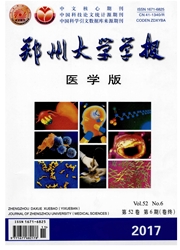

 中文摘要:
中文摘要:
目的:探讨脑缺氧缺血损伤(HI)对不同年龄小鼠脑组织神经干细胞增生与分化的影响。方法:结扎9d龄(P9)、21d龄(P21)C57/BL6小鼠(各10只)左侧颈总动脉后分别给予吸入体积分数为7.7%氧气的氮氧混合气35min(P9小鼠)/30min(P21小鼠),制成脑HI模型,选取相应天龄正常对照组小鼠各5只,连续腹腔注射新生细胞标记物5-溴脱氧尿嘧啶核苷(BrdU)7d,并分别于末次注射后4周处死小鼠并取脑,采用免疫组织化学染色及免疫荧光染色法分别以成熟神经元细胞标记物、少突细胞标记物、新生小胶质细胞标记物以及星形胶质细胞标记物检测不同日龄小鼠神经干细胞增生与细胞分化情况。结果:细胞增生随着脑组织发育快速下降;HI后P9小鼠皮层和纹状体的BrdU阳性细胞数显著增加,而在P21小鼠,大量的新生细胞仅发现于纹状体区;P9小鼠在皮层和纹状体区、P21小鼠仅在纹状体区检测到极少量新生细胞为成熟神经元细胞,多数分化为胶质细胞;HI后,P9小鼠3种新生胶质细胞在皮层和纹状体区均显著增高,P21小鼠仅发现在纹状体区新生小胶质细胞和星形胶质细胞均增加,新生少突细胞无明显改变。结论:适中的HI损伤可诱导神经干细胞增生和存活,细胞增生和分化与大脑区域和年龄相关。
 英文摘要:
英文摘要:
Aim: To investigate the effect of the hypoxia-ischemia brain injury on the cytogenesis with the different age. M ethods:C57/BL6 mice at postnatal day 9 and 21 were induced hypoxia ischemia (HI) by ligation of left carotid artery and inhalation of 7.7% oxygen for 35 rain (for P9)/30 min (for P21 ). Bromodeoxyuridine (BrdU) was injected into the brains in different development periods once a day for 7 d. The brains were retrieved 4 week's after the last BrdU injection. The mice with corresponding age were choosen for contnol group. Immunohistochemical and immunofluorescent studies were carried out for detecting cell proliferation (BrdU) and cell differentiation, respectively. Results : The cell proliferation decreased significantly with brain development. HI insult increased BrdU positive cells significantly in the ipsilateral cortex and striatum of the immature brain (P9). In the juvenile ( P21 ) , large amount of new born cells was only seen in the ipsilateral striatum. A small portion of BrdU and NeuN double labeled cells could be detected in the cortex and striatum of P9 and only in striatum of P21. The majority of BrdU labeled cells were neuroglia. HI insult stimulated to produce a large number of neuroglia cells in the ipsilateral cortex and stritum of P9 group. In the juvenile striatum, Ibal and S10013 positive cells increased 50 and 8 folds after HI, but the number of APC positive cells was no significant change. Conclusion : Moderate HI induced cell proliferation and survive, cell proliferation and differentiation were brain regions and age related.
 同期刊论文项目
同期刊论文项目
 同项目期刊论文
同项目期刊论文
 期刊信息
期刊信息
